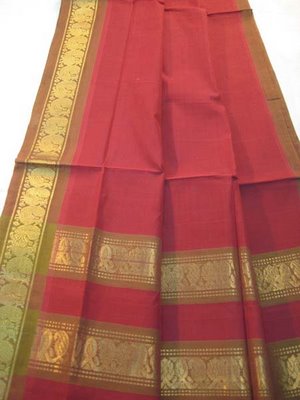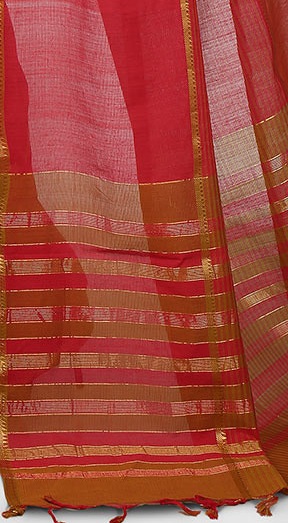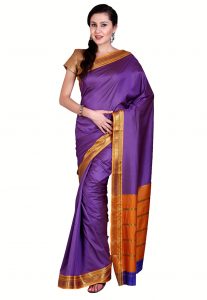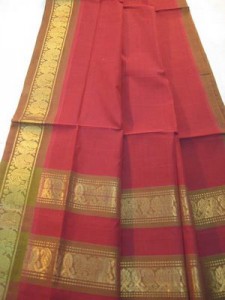
Mangalgiri Sarees

Mangalgiri Cotton Saree
Mangalgiri sarees and suit materials are a popular handloom product from the state of Andhra Pradesh. The name Mangalgiri is derived from the place Mangalgiri located 12 kms away from Vijayawada. The town of Mangalgiri is not only famous for its beautiful sarees but is also popular for being a pilgrimage destination as well.
This special saree has intricate tribal designs that are woven in cotton along with zari or golden colored patterns that occur in small checks. The pallu (edge) of this saree is adorned with a striped design, which is a typical tribal embellishment that is made out of golden embroidery. The Mangalgiri sarees come in a host of bold colors that make it look very elegant and gorgeous.
Origin & History
Before the sarees came into existence, Mangalgiri was always known for its pilgrimage importance because of the famous temple of Lord Panakala Narasimha Swamy that is located in the heart of the town. It is believed that this temple has been there since Satya Yuga and below the present temple lies the erstwhile Lakshmi Narasimha Swamy temple wherein Yudhistira had himself installed the main idol in the temple. However, the present temple was built in 1807-09 by Raja Vasireddi Venkatadri Naidu. It is said that as per the ancient traditions, the pilgrims had to purchase a sari from the local weavers after offering obeisance to the lord, which was another way of giving a livelihood to the local weavers. Thus grew the popularity of the Mangalgiri sari.
During the Qutub Shahi Dynasty in 1593, the region had levied taxes on the handloom sarees. Due to this, most of the weavers fled from the town, which dealt a severe blow to the flourishing handloom industry of the town of Mangalgiri. This development enabled the rulers to adopt a more favourable attitude with the weavers and reduce the taxes. In short, the pillar is proof enough that the Mangalgiri handloom tradition has been a part of the town for more than five centuries.
The Making
Mangalgiri cotton is produced by the cotton yarn that is purchased from the mills. This cotton yarn is then boiled in water and caustic soda for a couple of hours before it is suitable for dyeing. If the yarn is to produce white colored sarees, then it is bleached before weaving, else for coloring chemical dyes are used. After dyeing, the yarn is then sun dried before it is all set for the weaving process.

Woven Mangalgiri Cotton Saree in Purple
Since these sarees only have a zari border and zari on the pallu without any woven designs on the main body of the saree, therefore the fabric is woven only on pit looms, which enables the weaver to exert much more force during the weaving process without any gaps. This is what distinguishes the Mangalgiri textiles from other weaves.
Sources of Inspiration
The Mangalgiri saree has no embellishments on its main body. It has a zari or golden thread work embellished Nizam border and pallu. These geometrical and simple designs are inspired by the tribal designs.
Faces behind the Fabric
Mangalgiri is a small village that has a population of around eighty thousand people. Out of the total population, around 5000 of them are weavers of Mangalgiri textiles. The uniqueness of Mangalgiri cotton is due to its durability. The fabric is woven only on pit loom, and there are no gaps on the weave towards the edges of the fabric along with the sole fact that it is created in Mangalgiri alone.
Present Day Scenario
At present, handloom weaving is the prime occupation of Mangalgiri town and around half of the population depends on this cottage industry for their living. The beautifully woven sarees and dress materials that are produced by Mangalgiri are what have placed this small town on the world textile map.
Innovations
There are a lot of attempts being made at giving a modern twist to the Mangalgiri textiles. Apart from the exquisite and bright saree creations, the Mangalgiri dress materials have a global demand too. A lot of the new generation enjoy wearing the cool cotton kurtas, dupattas, nd stoles with the Mangalgiri weave which can be teamed up with western wear for a funky Indowestern look. Apart from that, jhola bags made with Mangalgiri fabric are also quite popular.
Global Appeal
Mangalgiri is a very popular handloom textile which has a lot of global demand owing to its simplistic patterns, durability of the cotton and colours and wearability
Maintenance
The golden thread or zari work demands that the sarees be dry cleaned. However, they can also be hand washed the second time onwards in cold water.
References
Categories: Textiles

